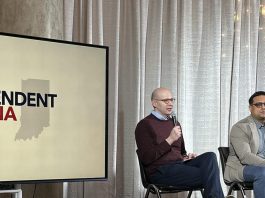Indiana Governor Candidate Highlights Racism And Bigotry With Provocative Message
By Erica Irish Â
TheStatehouseFile.com Â
INDIANAPOLIS — As he began his medical career at Stanford University and Harvard Medical School, Dr. Woody Myers says some professors assumed, just by the color of his skin, he was “too stupid to pass their class.â€
Myers, a Democrat now running for Indiana governor and the first Black candidate to campaign for the seat for either major party in the state, shared these and other intimate details in a new political ad Monday, “A Broken System.â€Â In a three-minute video, the doctor explores how his life experiences with bigotry and racism prepare him for the current challenges of the COVID-19 pandemic and renewed conversations around racial justice.

The uncensored ad opens with the camera trained on Myers’ face. He recounts a moment when a drunk patient called him the n-word as he tried to assist him in an emergency. Myers goes on to talk about a 17-year-old Black child who died after a hospital refused to give him a life-saving heart transplant because a surgeon “didn’t want to waste a good heart on a kid from the ghetto.â€
Myers doesn’t mention the campaign itself until the last few seconds of the ad, speaking instead to his qualifications as a former Indiana state health commissioner and director of healthcare for the international Ford Motor Company and how his experiences intersected with racism and other forms of bigotry, including the nation’s initial response to the AIDS epidemic.
“Now I’m running for governor of Indiana against Mike Pence’s hand-picked replacement because my life has led to this reckoning of a pandemic, an economic collapse, and a racial awakening,†Myers said in the ad.
Putnam Partners, a Washington, D.C.-based marketing firm known for producing provocative and non-traditional campaign ads for largely Democratic candidates, created the Myers ad. In 2018, for example, the group helped Democrat Jason Kander, running for a Senate seat in Missouri, create a 30-second ad in which he assembled an assault rifle while blindfolded to highlight his military experience and gun control policies.
Myers said he worked with the team about two weeks ago, where he spent several hours recalling his experiences in an interview.
“It was the single most painful day of my campaign,†Myers said about filming the ad and revisiting difficult experiences in his life. But he and his team wanted a video that would be honest about the experiences that motivate his work today so he can better connect with undecided voters.
The ad won’t air on television right away, Myers said, as his team is hopeful it will gain traction on social media websites and email. Though they haven’t ruled it out altogether, Myers said he is hesitant to rely only on televised ads based on his experiences running for Congress in 2008, where he lost to Rep. Andre Carson after spending most of the campaign’s money on commercials.
Republican Gov. Eric Holcomb released his first major television ad, “Proud to Be a Hoosier,â€Â on Aug. 7. Both this ad and the Myers ad are available on YouTube, wherein two weeks the Holcomb ad has garnered only 500 views, according to the total listed Wednesday. In two days, the Myers ad has garnered over 4,800 views. And those counts don’t include engagement on other social media sites, including Facebook, Twitter, and Instagram.

But the Holcomb ad could have an advantage: It is now being shared statewide on television, thanks to a seven-figure investment by the campaign.
“We’re excited to be up on the air with this uniting message,†Indiana Republican Party Chairman Kyle Hupfer said in a statement about the Holcomb ad.
As the incumbent, Holcomb also has the benefit of regular screen time during his weekly virtual COVID-19 briefing and other speeches. Soon after the death of George Floyd and protests that led to rioting and vandalism in downtown Indianapolis, for example, Holcomb gave a speech with Indiana State Police Superintendent Doug Carter about their commitment to ending police brutality.
But that speech was only a starting point, and Holcomb continued to face pressure from groups like the Indiana Black Legislative Caucus and Statehouse Democrats to call a special legislative session to reform law enforcement practices. On Tuesday, he gave another speech outlining new policies to promote equity and inclusion, including appointing a new cabinet member and requiring body-worn cameras for state police officers.
“I admit, I can’t put myself in a Black person’s shoes, can’t fully appreciate the everyday indignities and slights our friends and associates have had to deal with, let alone fear of some things I’ve never had to deal with,†Holcomb said in Tuesday’s speech. “So, I’ve spent considerable time since Mr. Floyd’s death connecting with and listening to Black leaders and stakeholders.â€
The Holcomb and Myers ads are perhaps as different as the candidates themselves, with Holcomb’s video much shorter and tailored to focus more on his work during the COVID-19 pandemic as well as Indiana’s response to the health crisis.
Mark Fraley, associate director of the non-partisan Political and Civic Engagement, or PACE, program at Indiana University in Bloomington, said this variation is a natural part of modern politics. Fraley served as chairman of the Monroe County Democratic Party 2015 to 2019 and now works with students from all political backgrounds.
Fraley said the main benefit of candidates choosing to humanize their messages, rather than rely on poll-tested speeches and talking points alone, is that they might connect with viewers at a deeper level and help create more genuine conversations in the election cycle.
“By the time you get boiled down to a particular message, it’s almost guided by the numbers, rather than the voice of the presenter themselves,†Fraley said while discussing the Myers ad. “And what this ad seems to do is treat the audience as if they’re something other than political abstractions, to be able to treat them like human beings and to speak of people like human beings.â€
An ad structured like the one Myers shared this week, Fraley added, is better suited for social media because it could prompt viewers to share it rather than watching it once during a televised commercial.
“An ad that’s meant to provoke some sort of emotion is much more likely to be shared across these digital spaces,†Fraley said.
But there also may be a risk in opening up with a personal message, Fraley said, which is why candidates still opt for traditional ads when possible. Even beyond Myers’ candidacy, sharing personal stories can always pose a risk to one’s reputation or career because one can never know how audiences might react.
Even still, Myers is likely at an advantage by choosing to go personal, Fraley said, since he is a Democrat running in a red state where Republicans have held the governor’s office for years.
“To run as a Democrat in the state of Indiana is something that’s very difficult,†Fraley said. “I think if you’re the underdog you have more room to go bold than otherwise.â€
The general election to determine Indiana’s next governor is Tuesday, Nov. 3. Early voting will begin in the state before that date, however, and it remains to be seen if state elected leaders will choose to expand no-excuse absentee voting as it did during the primary.
So far, however, state election leaders have refused to expand no-excuse absentee voting, and Holcomb continues to advocate for in-person voting during the election.
FOOTNOTE: Erica Irish is the 2020 Russell Pulliam editor for TheStatehouseFile.com, a news website powered by Franklin College journalism students. Â





Stanford and Harvard, huh? And still, as a Democrat, all he has to offer for himself is the racist card? Typical Democrat.
Comments are closed.